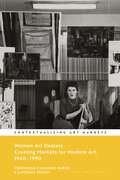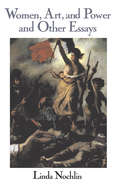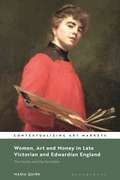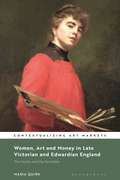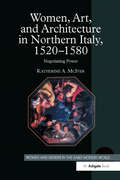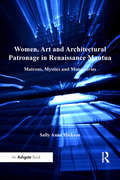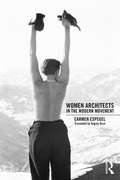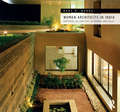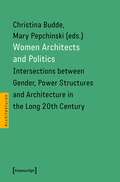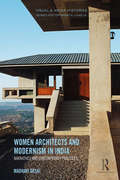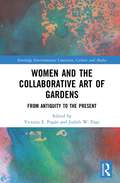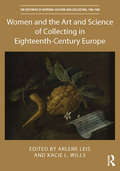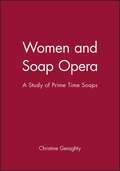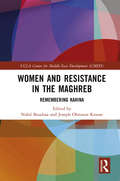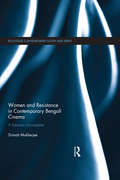- Table View
- List View
Women Art Dealers: Creating Markets for Modern Art, 1940–1990 (Contextualizing Art Markets)
by Véronique Chagnon-Burke and Caterina ToschiWomen Art Dealers brings together fascinating case studies of galleries run by women between the 1940s and 1980s. It marks a departure from other work in the field of art markets, challenging male-dominated histories by analyzing the work of female dealers who anticipated the global model, worked to promote art across continents, and thus developed an international art market. Part 1 focuses on the women gallerists behind the promotion of modern art after World War II who participated in important research about the neo-Avant-Garde. Part 2 examines the contributions by women art dealers toward the birth of new markets – through establishing the reputation of artistic genres, such as video art and photography, and working at the forefront of advancing contemporary art. Finally, Part 3 analyzes case studies from the southern European art scene, paying fresh attention to several under-researched markets in the region like Italy and Portugal. Each chapter study provides a historiographic profile of the gallery under discussion and critical analysis is supported with a wide range of visual material including portraits of the women art dealers, photographs of the exhibitions they managed, and printed documentation like catalogues, invitations, and posters that were often used to support artists on display in experimental ways.
Women Art Dealers: Creating Markets for Modern Art, 1940–1990 (Contextualizing Art Markets)
Women Art Dealers brings together fascinating case studies of galleries run by women between the 1940s and 1980s. It marks a departure from other work in the field of art markets, challenging male-dominated histories by analyzing the work of female dealers who anticipated the global model, worked to promote art across continents, and thus developed an international art market. Part 1 focuses on the women gallerists behind the promotion of modern art after World War II who participated in important research about the neo-Avant-Garde. Part 2 examines the contributions by women art dealers toward the birth of new markets – through establishing the reputation of artistic genres, such as video art and photography, and working at the forefront of advancing contemporary art. Finally, Part 3 analyzes case studies from the southern European art scene, paying fresh attention to several under-researched markets in the region like Italy and Portugal. Each chapter study provides a historiographic profile of the gallery under discussion and critical analysis is supported with a wide range of visual material including portraits of the women art dealers, photographs of the exhibitions they managed, and printed documentation like catalogues, invitations, and posters that were often used to support artists on display in experimental ways.
Women, Art, And Power And Other Essays
by Linda NochlinWomen, Art, and Power?seven landmark essays on women artists and women in art history?brings together the work of almost twenty years of scholarship and speculation.
Women, Art, And Power And Other Essays
by Linda NochlinWomen, Art, and Power?seven landmark essays on women artists and women in art history?brings together the work of almost twenty years of scholarship and speculation.
Women, Art and Money in England, 1880-1914: The Hustle and the Scramble (Contextualizing Art Markets)
by Maria QuirkWomen, Art and Money in England establishes the importance of women artists' commercial dealings to their professional identities and reputations in the late nineteenth and early twentieth centuries. Grounded in economic, social and art history, the book draws on and synthesises data from a broad range of documentary and archival sources to present a comprehensive history of women artists' professional status and business relationships within the complex and changing art market of late-Victorian England.By providing new insights into the routines and incomes of women artists, and the spaces where they created, exhibited and sold their art, this book challenges established ideas about what women had to do to be considered 'professional' artists. More important than a Royal Academy education or membership to exhibiting societies was a woman's ability to sell her work. This meant that women had strong incentive to paint in saleable, popular and 'middlebrow' genres, which reinforced prejudices towards women's 'naturally' inferior artistic ability – prejudices that continued far into the twentieth century.From shining a light on the difficult to trace pecuniary arrangements of little researched artists like Ethel Mortlock to offering new and direct comparisons between the incomes earned by male and female artists, and the genres, commissions and exhibitions that earned women the most money, Women, Art and Money is a timely contribution to the history of women's working lives that is relevant to a number of scholarly disciplines.
Women, Art and Money in England, 1880-1914: The Hustle and the Scramble (Contextualizing Art Markets)
by Maria QuirkWomen, Art and Money in England establishes the importance of women artists' commercial dealings to their professional identities and reputations in the late nineteenth and early twentieth centuries. Grounded in economic, social and art history, the book draws on and synthesises data from a broad range of documentary and archival sources to present a comprehensive history of women artists' professional status and business relationships within the complex and changing art market of late-Victorian England.By providing new insights into the routines and incomes of women artists, and the spaces where they created, exhibited and sold their art, this book challenges established ideas about what women had to do to be considered 'professional' artists. More important than a Royal Academy education or membership to exhibiting societies was a woman's ability to sell her work. This meant that women had strong incentive to paint in saleable, popular and 'middlebrow' genres, which reinforced prejudices towards women's 'naturally' inferior artistic ability – prejudices that continued far into the twentieth century.From shining a light on the difficult to trace pecuniary arrangements of little researched artists like Ethel Mortlock to offering new and direct comparisons between the incomes earned by male and female artists, and the genres, commissions and exhibitions that earned women the most money, Women, Art and Money is a timely contribution to the history of women's working lives that is relevant to a number of scholarly disciplines.
Women, Art, and Architecture in Northern Italy, 1520–1580: Negotiating Power (Women and Gender in the Early Modern World)
by Katherine A. McIverExpanding interdisciplinary investigations into gender and material culture, Katherine A. McIver here adds a new dimension to Renaissance patronage studies by considering domestic art - the decoration of the domestic interior - as opposed to patronage of the fine arts (painting, sculpture and architecture). Taking a multidimensional approach, McIver looks at women as collectors of precious material goods, as organizers of the early modern home, and as decorators of its interior. By analyzing the inventories of women's possessions, McIver considers the wide range of domestic objects that women owned, such as painted and inlaid chests, painted wall panels, tapestries, fine fabrics for wall and bed hangings, and elaborate jewelry (pendant earrings, brooches, garlands for the hair, necklaces and rings) as well as personal devotional objects. Considering all forms of patronage opportunities open to women, she evaluates their role in commissioning and utilizing works of art and architecture as a means of negotiating power in the court setting, in the process offering fresh insights into their lives, limitations, and the possibilities open to them as patrons. Using her subjects' financial records to track their sources of income and the circumstances under which it was spent, McIver thereby also provides insights into issues of Renaissance women's economic rights and responsibilities. The primary focus on the lives and patronage patterns of three relatively unknown women, Laura Pallavicina-Sanvitale, Giacoma Pallavicina and Camilla Pallavicina, provides a new model for understanding what women bought, displayed, collected and commissioned. By moving beyond the traditional artistic centers of Florence, Venice and Rome, analyzing instead women's artistic patronage in the feudal courts around Parma and Piacenza during the sixteenth century, McIver nuances our understanding of women's position and power both in and out of the home. Carefully integrating extensive archival
Women, Art, and Architecture in Northern Italy, 1520–1580: Negotiating Power (Women and Gender in the Early Modern World)
by Katherine A. McIverExpanding interdisciplinary investigations into gender and material culture, Katherine A. McIver here adds a new dimension to Renaissance patronage studies by considering domestic art - the decoration of the domestic interior - as opposed to patronage of the fine arts (painting, sculpture and architecture). Taking a multidimensional approach, McIver looks at women as collectors of precious material goods, as organizers of the early modern home, and as decorators of its interior. By analyzing the inventories of women's possessions, McIver considers the wide range of domestic objects that women owned, such as painted and inlaid chests, painted wall panels, tapestries, fine fabrics for wall and bed hangings, and elaborate jewelry (pendant earrings, brooches, garlands for the hair, necklaces and rings) as well as personal devotional objects. Considering all forms of patronage opportunities open to women, she evaluates their role in commissioning and utilizing works of art and architecture as a means of negotiating power in the court setting, in the process offering fresh insights into their lives, limitations, and the possibilities open to them as patrons. Using her subjects' financial records to track their sources of income and the circumstances under which it was spent, McIver thereby also provides insights into issues of Renaissance women's economic rights and responsibilities. The primary focus on the lives and patronage patterns of three relatively unknown women, Laura Pallavicina-Sanvitale, Giacoma Pallavicina and Camilla Pallavicina, provides a new model for understanding what women bought, displayed, collected and commissioned. By moving beyond the traditional artistic centers of Florence, Venice and Rome, analyzing instead women's artistic patronage in the feudal courts around Parma and Piacenza during the sixteenth century, McIver nuances our understanding of women's position and power both in and out of the home. Carefully integrating extensive archival
Women, Art and Architectural Patronage in Renaissance Mantua: Matrons, Mystics and Monasteries (Women and Gender in the Early Modern World)
by Sally Anne HicksonAnalyzing the artistic patronage of famous and lesser known women of Renaissance Mantua, and introducing new patronage paradigms that existed among those women, this study sheds new light the social, cultural and religious impact of the cult of female mystics of that city in the late fifteenth and early sixteenth century. Author Sally Hickson combines primary archival research, contextual analysis of the climate of female mysticism, and a re-examination of a number of visual objects (particularly altarpieces devoted to local beatae, saints and female founders of religious orders) to delineate ties between women both outside and inside the convent walls. The study contests the accepted perception of Isabella d'Este as a purely secular patron, exposing her role as a religious patron as well. Hickson introduces the figure of Margherita Cantelma and documents concerning the building and decoration of her monastery on the part of Isabella d'Este; and draws attention to the cultural and political activities of nuns of the Gonzaga family, particularly Isabella's daughter Livia Gonzaga who became a powerful agent in Mantuan civic life. Women, Art and Architectural Patronage in Renaissance Mantua provides insight into a complex and fluid world of sacred patronage, devotional practices and religious roles of secular women as well as nuns in Renaissance Mantua.
Women, Art and Architectural Patronage in Renaissance Mantua: Matrons, Mystics and Monasteries (Women and Gender in the Early Modern World)
by Sally Anne HicksonAnalyzing the artistic patronage of famous and lesser known women of Renaissance Mantua, and introducing new patronage paradigms that existed among those women, this study sheds new light the social, cultural and religious impact of the cult of female mystics of that city in the late fifteenth and early sixteenth century. Author Sally Hickson combines primary archival research, contextual analysis of the climate of female mysticism, and a re-examination of a number of visual objects (particularly altarpieces devoted to local beatae, saints and female founders of religious orders) to delineate ties between women both outside and inside the convent walls. The study contests the accepted perception of Isabella d'Este as a purely secular patron, exposing her role as a religious patron as well. Hickson introduces the figure of Margherita Cantelma and documents concerning the building and decoration of her monastery on the part of Isabella d'Este; and draws attention to the cultural and political activities of nuns of the Gonzaga family, particularly Isabella's daughter Livia Gonzaga who became a powerful agent in Mantuan civic life. Women, Art and Architectural Patronage in Renaissance Mantua provides insight into a complex and fluid world of sacred patronage, devotional practices and religious roles of secular women as well as nuns in Renaissance Mantua.
Women Architects in the Modern Movement
by Carmen EspegelHeroines of Space looks at four groundbreaking women architects: Eileen Gray, Lilly Reich, Margarethe Schütte-Lihotzky, and Charlotte Perriand. You'll see the parts they played in the history of modern architecture and get a clearer view of the recent past. The book explains the social and historical setting behind their coming into being and includes research on the factors around their roles as space makers to show you how they practiced architecture despite pressure not to. New in English, the Spanish edition won the 2006 Milka Blinakov Prize granted by the International Archive of Women in Architecture. Includes 150 black and white images and bibliographies for each architect.
Women Architects in the Modern Movement
by Carmen EspegelHeroines of Space looks at four groundbreaking women architects: Eileen Gray, Lilly Reich, Margarethe Schütte-Lihotzky, and Charlotte Perriand. You'll see the parts they played in the history of modern architecture and get a clearer view of the recent past. The book explains the social and historical setting behind their coming into being and includes research on the factors around their roles as space makers to show you how they practiced architecture despite pressure not to. New in English, the Spanish edition won the 2006 Milka Blinakov Prize granted by the International Archive of Women in Architecture. Includes 150 black and white images and bibliographies for each architect.
Women Architects in India: Histories of Practice in Mumbai and Delhi
by Mary N. WoodsAs the first inclusive study of how women have shaped the modern Indian built environment from the independence struggle until today, this book reveals a history that is largely unknown, not only in the West, but also in India. Educated in the 1930s and 1940s, the very first women architects designed everything from factories to museums in the post-independence period. The generations that followed are now responsible for metro systems, shopping malls, corporate headquarters, and IT campuses for a global India. But they also design schools, cultural centers, religious pilgrimage hotels, and wildlife sanctuaries. Pioneers in conserving historic buildings, these women also sustain and resurrect traditional crafts and materials, empower rural and marginalized communities, and create ecologically sustainable architectures for India. Today, although women make up a majority in India’s ever-increasing schools of architecture, it is still not easy for them, like their Western sisters, to find their place in the profession. Recounting the work and lives of Indian women as not only architects, but also builders and clients, opens a new window onto the complexities of feminism, modernism, and design practice in India and beyond. Set in the design centers of Mumbai and Delhi, this book is also one of the first histories of architectural education and practice in two very different cities that are now global centers. The diversity of practices represented here helps us to imagine other ways to create and build apart from "starchitecture." And how these women negotiate tradition and modernity at work and at home is crucial for understanding gender and modern architecture in a more global and less Eurocentric context. In a country where female emancipation was important for narratives of the independence movement and the new nation-state, feminism was, nonetheless, eschewed as divisive and damaging to the nationalist cause. Class, caste, tradition, and family restricted—but also created—opportunities for the very first women architects in India, just as they do now for the growing number of young women professionals today.
Women Architects in India: Histories of Practice in Mumbai and Delhi
by Mary N. WoodsAs the first inclusive study of how women have shaped the modern Indian built environment from the independence struggle until today, this book reveals a history that is largely unknown, not only in the West, but also in India. Educated in the 1930s and 1940s, the very first women architects designed everything from factories to museums in the post-independence period. The generations that followed are now responsible for metro systems, shopping malls, corporate headquarters, and IT campuses for a global India. But they also design schools, cultural centers, religious pilgrimage hotels, and wildlife sanctuaries. Pioneers in conserving historic buildings, these women also sustain and resurrect traditional crafts and materials, empower rural and marginalized communities, and create ecologically sustainable architectures for India. Today, although women make up a majority in India’s ever-increasing schools of architecture, it is still not easy for them, like their Western sisters, to find their place in the profession. Recounting the work and lives of Indian women as not only architects, but also builders and clients, opens a new window onto the complexities of feminism, modernism, and design practice in India and beyond. Set in the design centers of Mumbai and Delhi, this book is also one of the first histories of architectural education and practice in two very different cities that are now global centers. The diversity of practices represented here helps us to imagine other ways to create and build apart from "starchitecture." And how these women negotiate tradition and modernity at work and at home is crucial for understanding gender and modern architecture in a more global and less Eurocentric context. In a country where female emancipation was important for narratives of the independence movement and the new nation-state, feminism was, nonetheless, eschewed as divisive and damaging to the nationalist cause. Class, caste, tradition, and family restricted—but also created—opportunities for the very first women architects in India, just as they do now for the growing number of young women professionals today.
Women Architects and Politics: Intersections between Gender, Power Structures and Architecture in the Long 20th Century (Architekturen #60)
by Mary Pepchinski Christina BuddeIn the late 1960s, the feminist scholar Kate Millet broadly defined »politics« as arrangements of power which enable individuals collectively to assert authority over others. Taking this definition, case studies by scholars from Europe, Israel and the United States explore the gendered professional in the 20th century as she navigated arrangements of power including organised religion, emancipation movements, cultural norms and shifting forms of government to practice architecture. Additional contributions reflect upon power structures in contemporary architectural education, practice and history to propose other means of architectural knowledge, representation and professional activity.
Women Architects and Modernism in India: Narratives and contemporary practices (Visual and Media Histories)
by Madhavi DesaiStudies on architecture in South Asia continue to ignore women in canonical histories of the discipline. This book attempts to recover the stories of the women architects whose careers nearly parallel the development of modernism in colonial and postcolonial India. Writing their experiences into the narrative of mainstream architectural history within the challenge of non-existent archives, it sheds light on seven pioneering women who broke male bastions to go beyond the traditional confines of the era from the 1940s onwards. The author also examines 28 contemporary practices to demonstrate the ways in which architectural modernism in India was shaped by the contribution of women. The book uses a format that weaves together social, professional and biographical factors into a productive account; pluralizes various concepts of design; and redefines the idea of ‘work’ of women through a greater range of activities, including pedagogy, mentoring and activism. Alluding to challenges faced by women, the study celebrates practices in diverse regional settings even as the designers move in transnational contexts in an increasingly globalizing India. Extensively illustrated, featuring drawings and photographs, this book will be a milestone in the modernist narrative of South Asia and will be of interest to scholars and researchers of architecture, gender studies, modern Indian history and sociology.
Women Architects and Modernism in India: Narratives and contemporary practices (Visual and Media Histories)
by Madhavi DesaiStudies on architecture in South Asia continue to ignore women in canonical histories of the discipline. This book attempts to recover the stories of the women architects whose careers nearly parallel the development of modernism in colonial and postcolonial India. Writing their experiences into the narrative of mainstream architectural history within the challenge of non-existent archives, it sheds light on seven pioneering women who broke male bastions to go beyond the traditional confines of the era from the 1940s onwards. The author also examines 28 contemporary practices to demonstrate the ways in which architectural modernism in India was shaped by the contribution of women. The book uses a format that weaves together social, professional and biographical factors into a productive account; pluralizes various concepts of design; and redefines the idea of ‘work’ of women through a greater range of activities, including pedagogy, mentoring and activism. Alluding to challenges faced by women, the study celebrates practices in diverse regional settings even as the designers move in transnational contexts in an increasingly globalizing India. Extensively illustrated, featuring drawings and photographs, this book will be a milestone in the modernist narrative of South Asia and will be of interest to scholars and researchers of architecture, gender studies, modern Indian history and sociology.
Women and the Collaborative Art of Gardens: From Antiquity to the Present (Routledge Environmental Literature, Culture and Media)
by Victoria E. Pagán Judith W. PageWomen and the Collaborative Art of Gardens explores the garden and its agency in the history of the built and natural environments, as evidenced in landscape architecture, literature, art, archaeology, history, photography, and film. Throughout the book, each chapter centers the act of collaboration, from garden clubs of the early twentieth century as powerful models of women’s leadership, to the more intimate partnerships between family members, to the delicate relationship between artist and subject. Women emerge in every chapter, whether as gardeners, designers, owners, writers, illustrators, photographers, filmmakers, or subjects, but the contributors to this dynamic collection unseat common assumptions about the role of women in gardens to make manifest the significant ways in which women write themselves into the accounts of garden design, practice, and history. The book reveals the power of gardens to shape human existence, even as humans shape gardens and their representations in a variety of media, including brilliantly illuminated manuscripts, intricately carved architectural spaces, wall paintings, black and white photographs, and wood cuts. Ultimately, the volume reveals that gardens are best apprehended when understood as products of collaboration. The book will be of interest to scholars and students of gardens and culture, ancient Rome, art history, British literature, medieval France, film studies, women’s studies, photography, African American Studies, and landscape architecture.
Women and the Collaborative Art of Gardens: From Antiquity to the Present (Routledge Environmental Literature, Culture and Media)
Women and the Collaborative Art of Gardens explores the garden and its agency in the history of the built and natural environments, as evidenced in landscape architecture, literature, art, archaeology, history, photography, and film. Throughout the book, each chapter centers the act of collaboration, from garden clubs of the early twentieth century as powerful models of women’s leadership, to the more intimate partnerships between family members, to the delicate relationship between artist and subject. Women emerge in every chapter, whether as gardeners, designers, owners, writers, illustrators, photographers, filmmakers, or subjects, but the contributors to this dynamic collection unseat common assumptions about the role of women in gardens to make manifest the significant ways in which women write themselves into the accounts of garden design, practice, and history. The book reveals the power of gardens to shape human existence, even as humans shape gardens and their representations in a variety of media, including brilliantly illuminated manuscripts, intricately carved architectural spaces, wall paintings, black and white photographs, and wood cuts. Ultimately, the volume reveals that gardens are best apprehended when understood as products of collaboration. The book will be of interest to scholars and students of gardens and culture, ancient Rome, art history, British literature, medieval France, film studies, women’s studies, photography, African American Studies, and landscape architecture.
Women and the Art and Science of Collecting in Eighteenth-Century Europe (The Histories of Material Culture and Collecting, 1700-1950)
by Arlene Leis Kacie L. WillsThrough both longer essays and shorter case studies, this book examines the relationship of European women from various countries and backgrounds to collecting, in order to explore the social practices and material and visual cultures of collecting in eighteenth-century Europe.It recovers their lives and examines their interests, their methodologies, and their collections and objects—some of which have rarely been studied before. The book also considers women’s role as producers, that is, creators of objects that were collected. Detailed examination of the artefacts—both visually, and in relation to their historical contexts—exposes new ways of thinking about collecting in relation to the arts and sciences in eighteenth-century Europe. The book is interdisciplinary in its makeup and brings together scholars from a wide range of fields.It will be of interest to those working in art history, material and visual culture, history of collecting, history of science, literary studies, women’s studies, gender studies, and art conservation.
Women and the Art and Science of Collecting in Eighteenth-Century Europe (The Histories of Material Culture and Collecting, 1700-1950)
by Arlene Leis Kacie L. WillsThrough both longer essays and shorter case studies, this book examines the relationship of European women from various countries and backgrounds to collecting, in order to explore the social practices and material and visual cultures of collecting in eighteenth-century Europe.It recovers their lives and examines their interests, their methodologies, and their collections and objects—some of which have rarely been studied before. The book also considers women’s role as producers, that is, creators of objects that were collected. Detailed examination of the artefacts—both visually, and in relation to their historical contexts—exposes new ways of thinking about collecting in relation to the arts and sciences in eighteenth-century Europe. The book is interdisciplinary in its makeup and brings together scholars from a wide range of fields.It will be of interest to those working in art history, material and visual culture, history of collecting, history of science, literary studies, women’s studies, gender studies, and art conservation.
Women And Soap Opera: A Study Of Prime Time Soaps (Social Psychology And Society Ser.)
by Christine GeraghtyThis is the first major study of the roles of women in prime time soap operas. In a comparative analysis of British and North American television soaps, Christine Geraghty examines the relationship between the narratives on the screen and the women viewers who make up the traditional soap audience. Within the structure of many of the most popular soaps, such as Dallas, Dynasty, Coronation Street and EastEnders, the split between public and personal life, reason and emotion, work and leisure is turned into a lynchpin of the plot. The author argues that these themes are also linked to broader social divisions between men and women, divisions which soap operas both question and develop as a source of pleasure. Geraghty analyses the critical role of women characters in the families and communities of soaps and suggests that the utopian possibilities of soaps can be used not just to maintain the status quo, but to promote change and influence attitudes and prejudices. She examines the way in which soaps have been transformed in the last decade, looking at how issues of class, race, sexual orientation and feminism have been handled in the programmes. She argues that in pursuing new audiences more recent soaps such as Brookside may have put at risk the pleasures they have traditionally offered their women viewers. Women and Soap Opera is a detailed, thoughtful and wide-ranging analysis which will become a central work in women's studies and media and cultural studies courses.
Women and Resistance in the Maghreb: Remembering Kahina (UCLA Center for Middle East Development (CMED))
by Nabil BoudraaThis book studies women’s resistance in the three countries of the Maghreb, concentrating on two questions: First, what has been the role of women artists since the 1960s in unlocking traditions and emancipating women on their own terms? Second, why have Maghrebi women rarely been given the right to be heard since Algeria, Morocco, and Tunisia gained national independence? Honouring the artistic voices of women that have been largely eclipsed from both popular culture and political discourse in the Maghreb, the work specifically examines resistance by women since 1960s in the Maghreb through cinema, politics, and the arts. In an ancillary way, the volume addresses a wide range of questions that are specific to Maghrebi women related to upbringing, sexuality, marriage, education, representation, exclusion, and historical memory. These issues, in their broadest dimensions, opened the gates to responses in different fields in both the humanities and the social sciences. The research presents scholarship by not only leading scholars in Francophone studies, cultural history, and specialists in women studies, but also some of the most important film critics and practicing feminist advocates. The variety of periods and disciplines in this collection allow for a coherent and general understanding of Maghrebi societies since decolonization. The volume is a key resource to students and scholars interested in women’s studies, the Maghreb, and Middle East studies.
Women and Resistance in the Maghreb: Remembering Kahina (UCLA Center for Middle East Development (CMED))
by Nabil Boudraa Joseph Ohmann KrauseThis book studies women’s resistance in the three countries of the Maghreb, concentrating on two questions: First, what has been the role of women artists since the 1960s in unlocking traditions and emancipating women on their own terms? Second, why have Maghrebi women rarely been given the right to be heard since Algeria, Morocco, and Tunisia gained national independence? Honouring the artistic voices of women that have been largely eclipsed from both popular culture and political discourse in the Maghreb, the work specifically examines resistance by women since 1960s in the Maghreb through cinema, politics, and the arts. In an ancillary way, the volume addresses a wide range of questions that are specific to Maghrebi women related to upbringing, sexuality, marriage, education, representation, exclusion, and historical memory. These issues, in their broadest dimensions, opened the gates to responses in different fields in both the humanities and the social sciences. The research presents scholarship by not only leading scholars in Francophone studies, cultural history, and specialists in women studies, but also some of the most important film critics and practicing feminist advocates. The variety of periods and disciplines in this collection allow for a coherent and general understanding of Maghrebi societies since decolonization. The volume is a key resource to students and scholars interested in women’s studies, the Maghreb, and Middle East studies.
Women and Resistance in Contemporary Bengali Cinema: A Freedom Incomplete (Routledge Contemporary South Asia Series)
by Srimati MukherjeeHistorically, Indian cinema has positioned women at the intersection of tradition and a more evolving culture, portraying contradictory attitudes which affect women’s roles in public and private spheres. Examining the work of three directors from West Bengal, this book addresses the juxtaposition of tradition and culture regarding women in Bengali cinema. It argues the antithesis of women’s roles, particularly in terms of ideas of resistance, revolution, change, and autonomy, by suggesting they convey resistance to hegemonic structures, encouraging a re-envisioning of women’s positions within the familial-social matrix. Along with presenting a perception of culture as dynamic and evolving, the book discusses how some directors show that with this rupturing of the traditionally prohibitive, and a notion of unmaking and making in women, a traditional inclination is exposed to align women with ideas of absence, substitution, and disposability. The author goes on to show how selected auteurs in contemporary Bengali cinema break with certain traditional representations of women, gesturing towards a culture that is more liberating for women. Presenting the first full-length study of women’s changing roles over the last twenty years of Bengali cinema, this book will be a useful contribution for students and scholars of South Asian Culture, Film Studies and Gender Studies.
